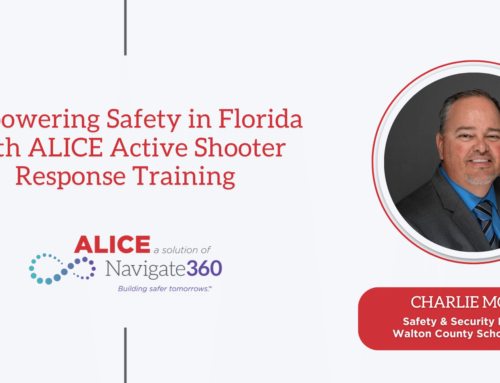
A lot of moving parts are in play when you conduct critical incident drills. Here’s why they should always be announced before they occur.
Safety drills are key to increasing employees’ and students’ knowledge of how to respond to an emergency or violence. They help prepare individuals to respond quickly, calmly, confidently, and safely should an actual critical incident take place.
Effectively running drills — such as Navigate360’s ALICE (Alert, Lockdown, Inform, Counter, Evacuate) active threat response drills — requires open communication throughout the entire process. At Navigate360, we strongly recommend all organizations announce planned critical incident drills in order to ensure the safety of everyone involved. Because drills involve a lot of moving parts, running them unannounced can cause major safety hazards. They can also cause panic and anxiety that is counterproductive to an efficient and well-organized drill.
The reasons for running periodic drills are varied. For one, drills allow you to identify potential areas of weakness in your team members’ training. In addition, drills allow you to test various processes and evaluate your incident command structure. They also provide drill participants a safe way to process their emotions and reactions in preparation for facing a real life-threatening, high-stress situation.
Clarity is Key
When an organization decides to run a violent critical incident drill, clear communication is key. When you announce “this is a drill” several times, everyone knows what is happening. Repeating this announcement addresses any auditory distractions as well.
“But if I run announced drills, people will not take them seriously.” Regarding this belief, our experience has shown that well-announced ALICE drills remove any potential trauma or stress that an unannounced drill may cause, and people do in fact take them just as seriously. Announcements of an upcoming ALICE drill should be made to first responders as well. Notifying first responders is important should someone call 911 for assistance.
If you fail to announce your drill to everyone who might be impacted, negative outcomes may result. For example, officers responding in emergency status may use firearms unnecessarily. Imagine you are at work and an announcement is made that there is an active shooter in the breakroom. You are just down the hall and you choose to evacuate the building. As you are in a full sprint out of the building, you are confronted by unwitting officers who point firearms at you. Later, you learn that the announcement was just a drill. How would you feel about this experience?
After the Drill
After your drill, you should complete an after-action report to identify and evaluate areas that need improvement. This will help your organization’s leaders identify personnel who might need to be retrained, as well as recognize areas of concern from an infrastructure standpoint. For example, you can identify and address the efficacy of your lighting, door locks, access to exits, PA systems and more. Once all areas of weakness are addressed and retraining completed, it’s important to conduct a new drill to test everything that was fixed.
Never Compromise Safety
At the end of the day, every ALICE drill and all drill-related training must make safety a top priority. At no time should safety be compromised for the sake of an experience. If you fail to announce drills and people get hurt both within the organization and externally, there is a level of liability that the organization and the person running the drill can shoulder. It’s not worth it to conduct ALICE drills (or any safety drills) in an unsafe manner. Remember, safety is everyone’s responsibility, and it starts with those in charge of drills.






